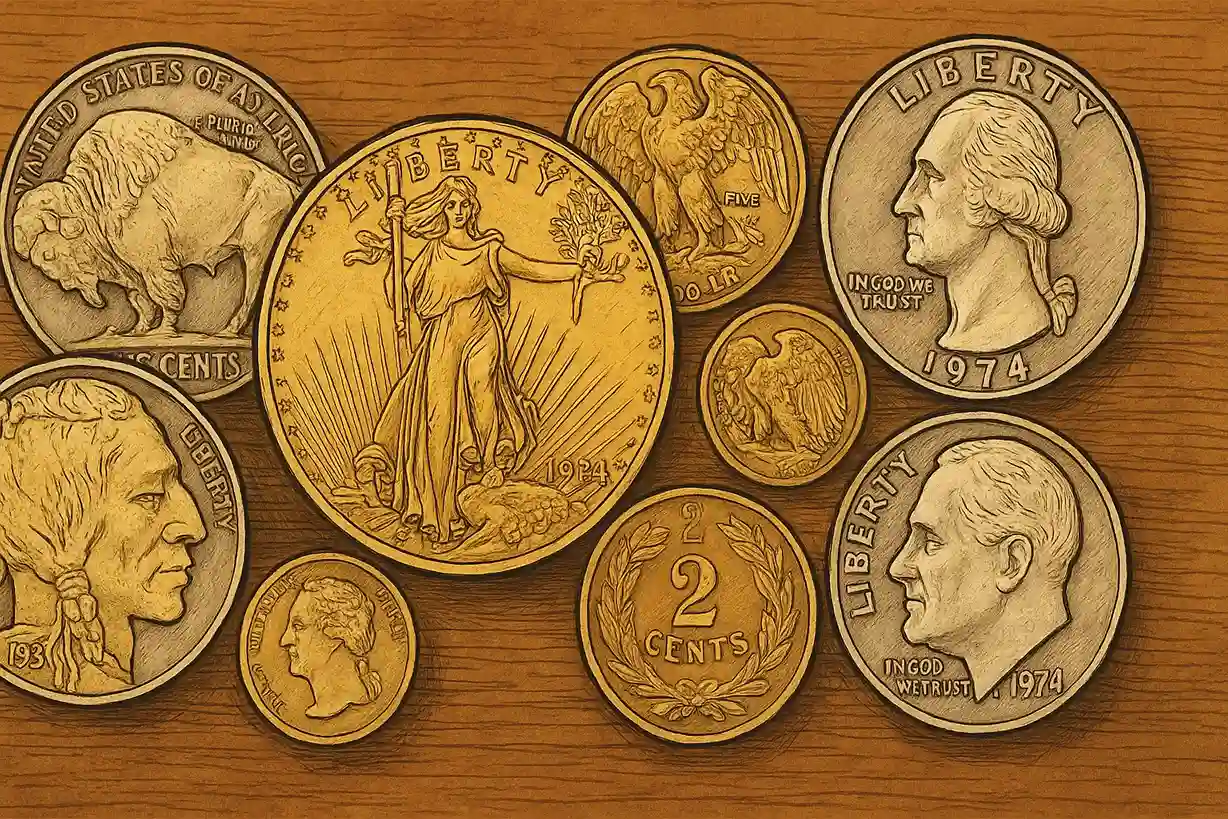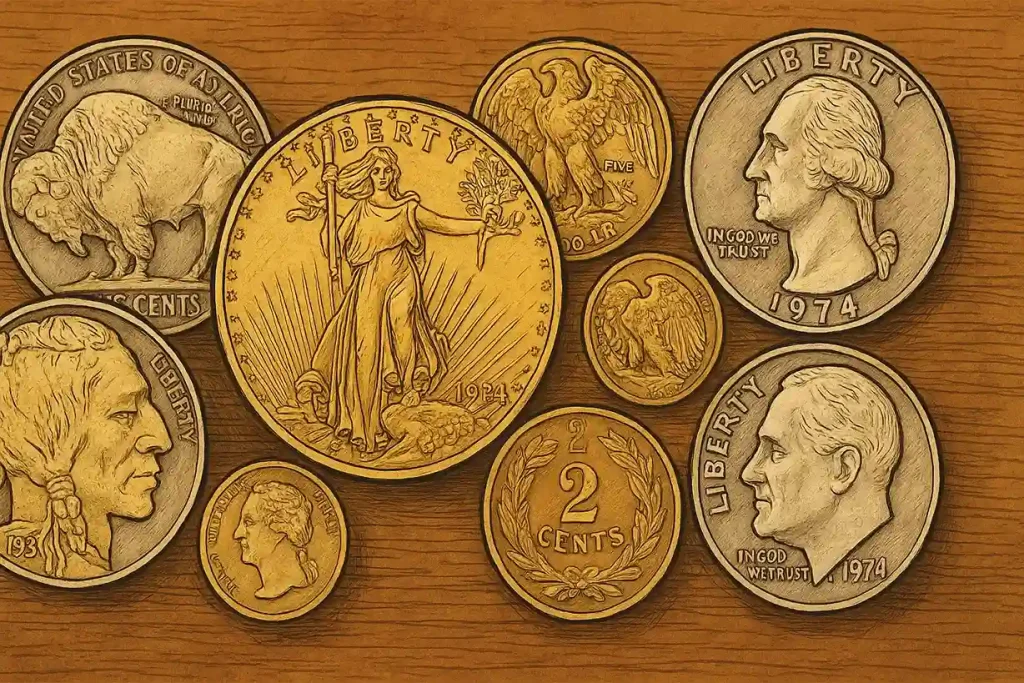What are you thinking about while holding a cent or a quarter? Coins aren’t just about commerce—they’re reflections of national identity, values, and moments frozen in time. In the United States, coinage has long served as more than simple legal tender. From the first minting operations in the 1790s to today’s collectible designs, U.S. coins offer a narrative arc that mirrors the evolution of American society, culture, and politics.
For example, Indian Head Buffalo nickel no date value is so high not only because of its age. What is more important — this coin and many others become valuable as they are tiny signs of historical changes in American history. Want to know more about such connections and some extraordinary cases? Keep on reading, we will tell you some of the most fantastic ones!

Why Coin Design Matters
Coinage is often overlooked in daily life, but it is, in essence, public art. Unlike paintings that reside in galleries, coins circulate in billions, touching hands across generations. The U.S. Mint has employed some of the country’s most talented engravers, sculptors, and artists to ensure each design carries both aesthetic value and historical depth. As society evolved, so too did the style and symbolism of American coins—resulting in numismatic legends that are as beautiful as they are meaningful.
A Glimpse at Artistic Legacy
Let’s take a moment to consider what makes a coin design “iconic.” The most revered coins share three traits:
- Timeless Artistic Composition: Balanced, meaningful, and enduring designs that remain relevant decades or even centuries later.
- Powerful Symbolism: Images that reflect a specific message or cultural milestone, such as national unity or resilience during wartime.
- Public Endearment: Beyond just collector value, truly iconic coins resonate with the public and often become cultural touchstones.
From the Victorian grace of Liberty Seated coins to the muscular energy of Saint-Gaudens’ high-relief masterpieces, these miniature artworks encapsulate America’s ambitions, challenges, and transformations.
Legendary Coin Designs and Their Stories
The story of American coinage is not just about metal and minting—it’s a visual language that speaks of heroism, freedom, unity, and resilience. Below are some of the most iconic U.S. coin designs that have not only stood the test of time but captured the hearts of collectors, historians, and everyday citizens alike.
🪙 Walking Liberty Half Dollar (1916–1947)
- Designer: Adolph A. Weinman
- Symbolism: Renewal, freedom, patriotism
Few coin designs are as universally admired as the Walking Liberty Half Dollar. Lady Liberty is shown striding toward the sunrise, draped in the American flag, olive branches in hand—symbolizing peace and victory. Her outstretched arm reaches forward with determination and grace. The reverse features a vigilant eagle perched on a rock, wings slightly lifted as if ready to soar.
This powerful imagery represented a nation recovering from war and stepping boldly into a new era. It was so beloved that it was chosen as the model for the modern American Silver Eagle bullion coin beginning in 1986.
🛡 Standing Liberty Quarter (1916–1930)
- Designer: Hermon A. MacNeil
- Symbolism: Peace through strength
Liberty takes center stage in this stunning design, standing boldly between two columns. She holds a shield in one hand and an olive branch in the other, prepared to defend or to make peace. The design evolved over time due to modesty concerns (Liberty’s exposed breast was later covered by chainmail), but its essence remained: a nation ready to protect its values.
The reverse features an eagle in flight—a classic symbol of freedom and aspiration. This quarter marked a significant shift in U.S. coin design toward more human, emotionally resonant figures.
🦅 Morgan Silver Dollar (1878–1904, 1921)
- Designer: George T. Morgan
- Symbolism: Strength, expansion, Western frontier spirit
The Morgan Dollar is perhaps the most iconic of all American silver coins. Minted during a time of booming silver mines and westward expansion, it features a youthful, robust Liberty modeled after an American schoolteacher—an unusual choice at the time. The reverse showcases a proud eagle with wings spread wide, gripping arrows and an olive branch.
Its heavy weight, large diameter, and distinctive relief make it a staple in American numismatics. For collectors, the Morgan Dollar represents not just beauty, but an entire era of industrial growth and rugged independence.

🕊 Saint-Gaudens Double Eagle ($20 Gold Coin, 1907–1933)
- Designer: Augustus Saint-Gaudens
- Symbolism: Triumph, idealism, rebirth
Commissioned by President Theodore Roosevelt as part of his “American Renaissance” in coin design, the Saint-Gaudens Double Eagle is often considered the most beautiful coin ever produced by the U.S. Mint.
Liberty strides confidently, torch aloft, hair blowing in the wind, with the Capitol building faintly visible in the background. The reverse is equally majestic, with a bald eagle soaring across a sun-drenched sky. The coin’s high-relief format made it technically difficult to mint, but its dramatic impact was undeniable.
Today, owning a Saint-Gaudens coin is like holding a piece of sculptural art in gold—a genuine masterpiece of American creativity.
🇺🇸 Washington Quarter (1932–present)
- Designer: John Flanagan
- Symbolism: Leadership, unity, historical reverence
Originally intended as a one-year commemorative issue to honor George Washington’s 200th birthday, the Washington Quarter was so well-received that it became a permanent fixture.
Flanagan’s portrayal of Washington is bold and stoic, and the coin’s reverse has changed over the decades—from the original eagle to 50 unique state designs, national parks, and even American women in recent issues. This adaptability shows how a foundational design can evolve while maintaining core values.
✝️ Two-Cent Piece (1864–1873)
- Designer: James B. Longacre
- Symbolism: Faith, unity during conflict
Though often overlooked, the Two-Cent Piece has a unique place in history. It was the first coin to bear the motto “In God We Trust”, a phrase added during the Civil War to reflect the nation’s appeal to divine guidance in troubled times.
With a bold shield on the obverse and simple laurel wreath on the reverse, it’s a compact yet powerful design. Its unusual denomination also makes it a popular talking point for collectors and educators.
Why These Designs Became Iconic
What sets these coins apart is not just their artistic merit, but the stories they tell:
- They reflect pivotal moments in U.S. history, from the optimism of the early 20th century to the resilience of the Civil War era.
- Their symbolism-Liberty, eagles, shields-embodies American ideals.
- Their designs have stood the test of time, influencing modern coinage and remaining beloved by collectors and the public alike.
How to Identify and Evaluate Your Coins
Identifying a coin involves more than reading the date. Key factors that influence value and historical interest include:
- Mint Marks: Tiny letters (such as “D” for Denver or “S” for San Francisco) indicate the coin’s mint of origin and can significantly affect value.
- Condition: Coins in better condition (graded from Good to Mint State) are more desirable and fetch higher prices.
- Rarity: Lower-mintage coins, unique errors, or discontinued designs often carry premium worth.
- Design Details: Subtle changes in Liberty’s hairstyle, the position of stars, or reverse elements can denote valuable varieties.
For beginners and seasoned collectors alike, analyzing these details used to require thick catalogs, hours of research, and expert consultations. Today, however, digital tools can simplify the process dramatically.
📱 Coin ID Scanner App: Your Pocket-Sized Numismatic Assistant
Whether you’ve just started your collection or inherited a box of old change, the Coin ID Scanner app can help unlock the value of your finds—literally with a tap.
🛠 How It Works:
- Open the app on your smartphone.
- Take a clear photo of the front and back of the coin (you will see some tips on doing it right).
- Get instant results: The app uses image recognition and an extensive database to identify the coin, determine its origin, provide estimated value ranges, and highlight key features or varieties.
- Access grading and rarity insights, along with historical context for each coin.
- Save your collection within the app for tracking, organization, or future sales.
This tool removes barriers and empowers users—especially families and young collectors—to dive into the hobby with confidence. No guesswork. No expert needed. Just curiosity and a smartphone.
Behind every iconic U.S. coin lies a narrative that connects art, history, and identity. From the poised strength of Lady Liberty to the bold legacy of George Washington, these miniature canvases reflect the values and spirit of America across centuries.
Thanks to tools like the Coin ID Scanner app, a growing numismatic community, and a wealth of online resources, anyone can become a storyteller of coins. So next time you find a shiny quarter or a dusty silver dollar, remember: you’re not just holding money—you’re holding a piece of the American saga.
Happy collecting, and let your family’s numismatic journey begin.





